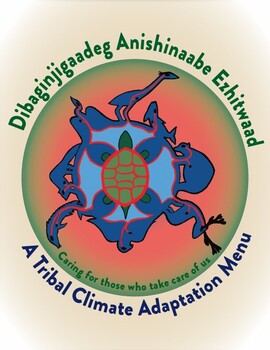Tribal climate adaptation menu
tribal resilience

Many climate adaptation planning tools fail to address the unique needs, values and cultures of Indigenous communities. The Tribal Climate Adaptation Menu, which was developed by a diverse group of collaborators representing tribal, academic, intertribal and government entities in Minnesota, Wisconsin and Michigan, provides a framework to integrate indigenous and traditional knowledge, culture, language and history into the climate adaptation planning process.
The Menu is an extensive collection of climate change adaptation actions for natural resource management, organized into tiers of general and more specific ideas.While this first version of the Menu was created based on Ojibwe and Menominee perspectives, languages, concepts and values, it was intentionally designed to be adaptable to other indigenous communities, allowing for the incorporation of their language, knowledge and culture.
Guiding principles for interacting with tribes
Primarily developed for the use of indigenous communities, tribal natural resource agencies and their non-indigenous partners, the Tribal Climate Adaptation Menu may be useful in bridging communication barriers for non-tribal persons or organizations interested in indigenous approaches to climate adaptation and the needs and values of tribal communities.
Importance of human/Non-human relationships & Approaching knowledge holders

Indigenous knowledges and ways recognize plant, animal, and other spirit beings as our original teachers. While conventional land management favors direct intervention, with humans controlling the natural world, indigenous perspectives emphasize the importance of learning from other beings and natural communities. This Strategy involves taking time to observe and learn from the beings in a given area. This idea may become even more important in an era of climate change, as shifting conditions result in cascading ecosystem impacts and unexpected outcomes.
Cultural leaders, community members, harvesters, elders, and other key individuals have important knowledges and perspectives that can inform climate adaptation activities. Taking time to build relationships and properly consult with the broader community will result in more informed decisions and more support for adaptation actions. The Tribal Climate Adaptation Menu provides readers with mindful practices of reciprocity and etiquette on how to offer Asemaa/nāēqnemaw (tobacco) when asking knowledge holders for information.
adaptation strategies and approaches
Supporting Tribal Engagement in the Environment
Climate adaptation can both encourage and rely on relationships among tribal communities and the lands, waters, and other beings of an area. Supporting and revitalizing these relationships may improve both human and non-human community health and lead to greater community involvement and ownership over land management processes and decisions. Increasing awareness of opportunities for tribal members to use tribal and public lands for harvesting, culture, and recreation will increase knowledge of and relationships with an area, which may lead to greater engagement with adaptation actions and their potential success.
Early each fall semester, native students from Ashland, Mille Lacs, Lac Courte Oreilles and other schools attend manoomin camp on Ceded Territory wild rice waters. Bringing the classroom outdoors replicates century-old Ojibwe traditions and creates opportunities for youth to acquire essential harvest skills.
Inventory and monitoring programs can help assess changes as they occur, which can be crucial when making decisions about climate adaptation. Inventory and monitoring programs are also a way to involve community members, school groups, and professional staff to the shared process of observing and caring for the local environment.
Tribal input and involvement can influence local- to landscape-scale management decisions when tribes effectively partner with county, state, and federal land management agencies in climate adaptation planning. All potential partners must work to address cultural and administrative barriers that may impede effective collaboration. Intertribal organizations and other “boundary-spanning” organizations can support these relationships and other co-management efforts.
At the 25th anniversary celebration of the Tribal–USDA Forest Service Memorandum of Understanding (MOU), leadership from GLIFWC and the Forest Service exchange gifts to commemorate many years of a healthy working relationship.
Sustaining ecological & cultural functions
Climate adaptation actions will need to focus on maintaining the integrity of ecosystems and supporting cultural relationships in a changing climate. The following images illustrate different ways to sustain native cultural and ecological systems such as hydrology and soils, riparian areas, nibi (water) quality, plant communities, cultural use of ishkode (fire) as a stewardship tool, and revitalization of cultural approaches to harvesting and caretaking.
Reducing biological & anthropogenic stressors
and Long-term impacts of disturbances
Climate change will cause stress and changes within native ecosystems, and is projected to increase the potential for severe disturbance events, such as wildfire, extreme wind, and ice storms. These climate-driven stressors and disturbances can interact with other stressors that may already be occurring on the landscape, and have the potential to alter natural ecosystems over large landscapes. Reducing the effects of biological stressors such as bakaan ingoji gaondaadag (non-local beings) and human-caused stressors like water pollution and soil disturbance can be an important part of a climate adaptation plan. The Approaches that follow describe some of the different ways of maintaining clean air, clean water, and clean land that are detailed in the Tribal Climate Adaptation Menu.